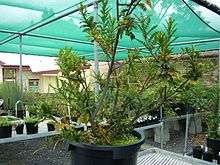Lomatia tasmanica
| King's Lomatia | |
|---|---|
 | |
| Lomatia tasmanica in Hobart Botanical Garden | |
| Scientific classification | |
| Kingdom: | Plantae |
| (unranked): | Angiosperms |
| (unranked): | Eudicots |
| Order: | Proteales |
| Family: | Proteaceae |
| Genus: | Lomatia |
| Species: | L. tasmanica |
| Binomial name | |
| Lomatia tasmanica W.M.Curtis[2] | |
Lomatia tasmanica, commonly known as King's lomatia, is a Tasmanian shrub from the family Proteaceae. The plant has shiny green leaves and bears pink flowers, but yields neither fruit nor seeds. Only one colony of King's lomatia is known to be alive in the wild. It is also sometimes called "King's holly", though it is not a holly.
King's lomatia is unusual because all of the remaining plants are genetically identical. Because it has three sets of chromosomes (a triploid) and is therefore sterile, reproduction occurs only vegetatively: when a branch falls, that branch grows new roots, establishing a new plant that is genetically identical to its parent.
Although all the plants are technically separate in that each has its own root system, they are collectively considered to be one of the oldest living plant clones. Each plant's life span is approximately 300 years, but the plant has been cloning itself for at least 43,600 years (possibly up to 135,000 years).[3][4] This estimate is based on the radiocarbon dating of fossilised leaf fragments that were found 8.5 km (5.3 mi) away. The fossilised fragments are identical to the contemporary plant in cell structure and shape, which indicates that both plants are triploid and therefore clones due to the extreme rarity of the occurrence of triploidy.
Description
The individual plants of L. tasmanica are straggly shrubs to 5 m high, their upper branchlets covered in fine rusty fur. The leaves are alternately arranged on the stems. Pinnate, they are 10-18 cm long. Flowers appear in February.
History
In 1937 Charles Denison "Deny" King discovered the plant while mining tin in the remote southwest of Tasmania. The Tasmanian Herbarium named the plant in King's honour after he sent specimens to be identified in the 1960s. The plant group that King discovered in 1937 has disappeared (and likely died out), and the sole remaining group of approximately 500 plants covers a 1.2 kilometer-long area in the extreme southwest of Tasmania. This area is prone to fires and other natural threats to the plants, so Tasmania has begun an effort to develop other populations in controlled environments such as the Royal Tasmanian Botanical Gardens. (Because of its fragility and rarity, their specimens are not on display to the public.) Due to its inability to reproduce sexually, there is no possibility of increasing the plant's genetic diversity to promote disease resistance.
However, on 19 September 2009, the Royal Tasmanian Botanical Gardens issued a media release regarding the propagation efforts saying: "The Royal Tasmanian Botanical Gardens [RTBG] is working towards securing the future of a rare and ancient Tasmanian native plant... Lomatia tasmanica, commonly known as King's Lomatia, is critically endangered with less than 500 plants growing in the wild in a tiny pocket of Tasmania's isolated south west. The RTBG has been propagating the plant from cuttings since 1994... 'Fossil leaves of the plant found in the south west were dated at 43,600 years old and given that the species is a clone, it is possibly the oldest living plant in the world".[5]
See also
References
- ↑ "Lomatia tasmanica — King's Lomatia". Species Profile and Threats Database. Australian Department of Sustainability, Environment, Water, Population and Communities. Retrieved 11 Nov 2013.
- ↑ "Lomatia tasmanica W.M.Curtis". Australian Plant Name Index (APNI), IBIS database. Centre for Plant Biodiversity Research, Australian Government. Retrieved 11 Nov 2013.
- ↑ Lynch, A. J. J.; Barnes, R. W.; Vaillancourt, R. E.; Cambecèdes, J. (1998). "Genetic evidence that Lomatia tasmanica (Proteaceae) is an ancient clone" (PDF). Australian Journal of Botany. 46 (1): 25–33. doi:10.1071/BT96120. Retrieved 11 Nov 2013.
- ↑ "The Oldest Living Plant Individual". Botanical Electronic News. 8 Nov 1996. Retrieved 11 Nov 2013.
- ↑ "Botanists collaborate to secure future of rare Tasmanian plant". Royal Tasmanian Botanical Gardens. 11 Nov 2013.
External links
- "King, Charles Denison (1909–1991)". Australian Government Department of the Environment and Heritage. Retrieved 29 January 2005.
- "Kings lomatia". Tasmanian Department of Primary Industries, Water and Environment. Retrieved 29 January 2005.
- "Threatened Species: King's Lomatia". Tasmanian Parks and Wildlife Service. Retrieved 19 October 2005.
